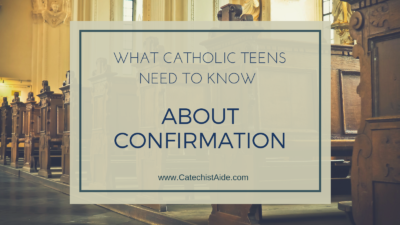What do we mean when we say “mark?”
You (or your students) may be familiar with the meme, “That’s gonna leave a mark!” The internet is full of examples, like this one:

As the woman in the GIF is about to find out, a mark is a visible sign.
So, when we say that the marks of the Church are one, holy, catholic and apostolic, we’re not only describing the Church, we are saying that these attributes, which were first shared with the Church by its founder Jesus Christ through the Holy Spirit, are visible within the Church today. From the Catechism of the Catholic Church,
“These four characteristics, inseparably linked with each other, indicate essential features of the Church and her mission.” (CCC 811)
Today we’ll look in detail at the first of these marks.
The Church is ONE
When we say that the Church is one we are referring to the unity of the Church. The Church is a community of believers. It is us, and we are a unified community.
What does a unified group look life? It is a group of people who are united in beliefs, in purpose, in goals, in vision, and in spirit. Other examples that your students might relate to would be a sports team or the military.
It’s important to recognize that not every group is a unified group. Most teens will relate to being assigned to a group for a project at school. However, these groups can produce mixed results. Just because a group of people comes together does not make them unified. Unfortunately, because some groups are chosen randomly, they may lack unity. The result is usually a subpar effort, not to mention frustration and bad feelings as well.
But there is a perfect example of true unity, and that is the source of the Church, God himself, in the Holy Trinity. God, as Father, Son, and Holy Spirit, who is ONE.
Unified at its founding
The unity of the Catholic Church goes back to its earliest roots. The Acts of the Apostles details these early days and tells us the “The community of believers was of one heart and mind.” (Acts 4:32; emphasis added) Jesus had been the unifying source in the Church while he lived on earth. But, Jesus knew that he would be leaving his apostles to carry on without him. He knew that they would need the presence of God to unify them in their mission to grow the Church and live as Christians. So Jesus sent the Holy Spirit to unite the Apostles and strengthen them to carry on in His name. The Holy Spirit remains the unifying force of the Church on earth today.
The Church is one because of her “soul”: “It is the Holy Spirit, dwelling in those who believe and pervading and ruling over the entire Church, who brings about that wonderful communion of the faithful and joins them together so intimately in Christ that he is the principle of the Church’s unity.” (CCC 813)
Wounds to Unity
Of course, the Church can suffer wounds to its unity, its oneness. History has shown, and we see evidence today, that there can be disagreements, divisions, separations, and scandal within the Church. The Catechism reminds us that,
“Christ bestowed unity on his Church from the beginning. This unity, we believe, subsists in the Catholic Church as something she can never lose, … but the Church must always pray and work to maintain, reinforce and protect the unity that Christ wills for her.” (CCC 820)
I was recently reminded of the importance of the laity in our Church, and our duty to help preserve her unity. In a blog post for Word on Fire, Elizabeth Scalia recalled the words of Archbishop Fulton Sheen which, as she points out, although written in 1972 are “most relevant to our times:”
“Who is going to save our Church? Not our bishops, not our priests and religious. It is up to you, the people. You have the minds, the eyes, and the ears to save the Church. Your mission is to see that your priests act like priests, your bishops act like bishops, and your religious act like religious.”
Takeaway for Teens
The best way for all Catholics to “maintain, reinforce and protect the unity” of the Church is through fervent prayer and a better understanding of the faith that we profess. Learning what we believe, and why we believe doesn’t stop with Confirmation. We must continue our education in the faith throughout our lives, preserve it, and live it, bringing it out into the world.
© 2018 Catechist’s Aide





